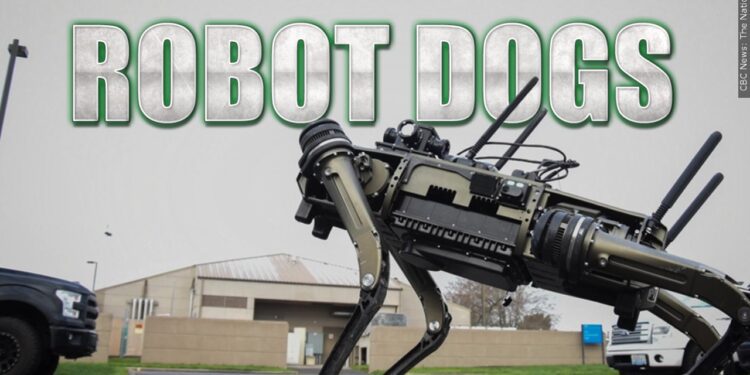LOOTPRESS – In a significant development that underscores the rapid evolution of military technology, the United States Army recently conducted a high-profile test of a four-legged unmanned ground vehicle (UGV), commonly referred to as a “robot dog,” equipped with an AI-enabled rifle.
This exercise, part of the larger Operation Hard Kill collaboration between the U.S. Army’s DEVCOM and the 10th Mountain Division, represents a concerted effort to address the growing threat posed by unmanned aircraft systems.
The test footage, which has garnered widespread attention, depicts a human operator utilizing a tablet to remotely control the maneuvering of the robot dog and its integrated weapon system. The robot in question, the Ghost Robotics Vision 60 Q-UGV, boasts an array of advanced features, including a sophisticated targeting system, a turret that houses the firearm, and a forward-facing camera that enhances the operator’s situational awareness.
Ghost Robotics, the manufacturer of the Vision 60, markets the platform as an all-weather ground drone suitable for a variety of defense, homeland security, and commercial applications. The robot’s impressive specifications include a weight of approximately 112 pounds, a payload capacity of 22 pounds, a runtime of up to three hours, and a top speed of around 6.7 miles per hour.
Moreover, the company has a significant customer base, serving over 25 national security entities and having shipped more than 450 of these robotic systems worldwide. The potential military applications of the Vision 60 are further highlighted by The War Zone’s analysis, which suggests that the robot dog’s ability to navigate terrain typically inaccessible to human troops could provide a crucial advantage in counter-drone operations.
By positioning the robot in strategic vantage points, it can potentially expand its field of fire and offer enhanced protection against airborne threats.
This latest test by the U.S. Army builds upon a growing trend of military experimentation with UGVs, such as the recent deployment of robotic dogs by a light infantry company to sense and scout their surroundings in a simulated environment.
Furthermore, other nations, including Russia and China, have also reportedly explored the use of robot dogs in military applications, with Russia developing a UGV equipped with an anti-tank rocket launcher and China unveiling a rifle-wielding robotic canine. As the world’s militaries continue to embrace these cutting-edge technologies, the implications for the future of warfare and force protection become increasingly profound.









